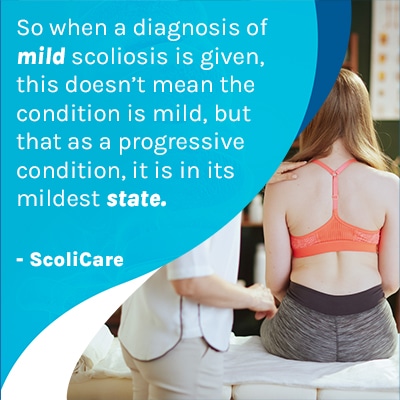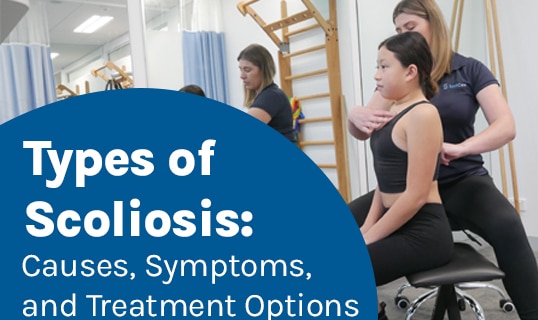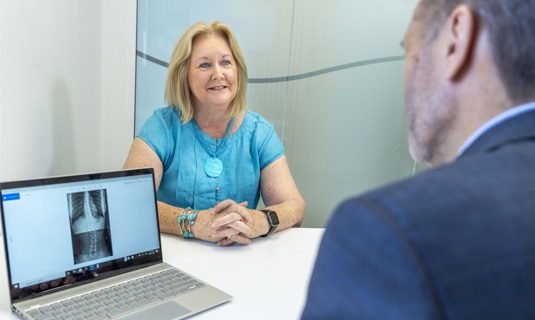The most important thing to understand about mild scoliosis is that in most cases, proactive treatment efforts have to be made to keep the condition mild and prevent it from becoming moderate or severe scoliosis.
As a progressive condition, even scoliosis that’s mild at the time of diagnosis isn’t guaranteed to stay mild. Symptoms of mild scoliosis can be subtle, but there are benefits associated with recognizing the condition’s early signs so treatment can be started early.
Treatment success starts with a comprehensive initial assessment that involves a physical examination, postural assessment, and X-ray results are needed to reach an official diagnosis.
Assessing Scoliosis
Diagnosing scoliosis isn’t always easy, particularly when mild, and part of the process involves an initial comprehensive assessment looking for indicators of scoliosis.
Determining the best course of treatment starts with the initial assessment, and ScoliCare Clinicians take a thorough patient history, perform a physical examination that includes an Adams forward bend test, assess posture, and if necessary, take X-rays.
Scoliosis causes the spine to develop an unhealthy side to side curve, and to be diagnosed as scoliosis, the curve has to be of a minimum size and there has to be rotation present.
Diagnosing Scoliosis
A scoliosis X-ray is the only way to diagnose and measure scoliosis, and this is part of determining the severity of the condition.
Standing X-rays accurately show the spine’s misalignment, while X-rays performed while the patient is lying down, which isn’t uncommon, should not be used for diagnosis but can be compared to standing X-rays to give an indication of curve flexibility (the more a curve reduces in lying the more likely the curve is flexible) (2).
If scoliosis isn’t measured accurately, treatment plans are being designed around inaccurate information, and the more precise and accurate the initial scoliosis measurements taken during X-ray are, the more precise potential treatment results can be.
In childhood scoliosis, X-rays are also helpful in assessing bone age; as a progressive condition triggered by growth, how much growth a patient has remaining before reaching skeletal maturity can indicate the risk of potential progression (2).
In older adult patients, X-rays are important for assessing the spine’s balance and stability because if a certain level of instability is present, these patients are at risk of injury through falls.
So, to officially diagnose scoliosis, the unnatural sideways-bending spinal curve has to rotate and have a minimum Cobb angle measurement of 10 degrees.
Cobb Angle and Condition Severity
A scoliosis curve has to be over 10 degrees, and this is determined by a patient’s Cobb angle measurement on X-ray.
By measuring the curve’s most rotated vertebrae and how far out of alignment the spine is, the scoliosis severity can be determined, and scoliosis can be classified as mild scoliosis, moderate scoliosis, or severe scoliosis. However, even a ‘mild’ scoliosis can be at high risk of progression so the categories should be interpreted with caution.
Scoliosis that’s diagnosed as mild doesn’t mean there is less urgency; it doesn’t mean there is more time to observe and decide on a course of treatment because scoliosis isn’t a static condition; mild cases can still progress rapidly, particularly in children who are still growing.
Condition severity has to be determined accurately because treatment plans are shaped around it. But condition severity goes beyond just the size of the curve.
What is Mild Scoliosis?
 So when a diagnosis of mild scoliosis is given, this doesn’t mean the condition is mild, but that as a progressive condition, it is in its mildest state.
So when a diagnosis of mild scoliosis is given, this doesn’t mean the condition is mild, but that as a progressive condition, it is in its mildest state.
A Cobb angle measurement of between 10 and 25 degrees is present while conditions are considered mild, but it’s important to understand that conditions diagnosed as mild still need to be taken seriously, and condition severity is about potential progression, in addition to curve size.
Mild scoliosis does not guarantee that the curve will not progress, and understanding this is crucial for effective management. If a patient has significant growth remaining—such as during adolescence—or if the curve type is prone to rapid progression, such as single thoracic curves which can advance more quickly than others, the condition may worsen over time. This underscores the importance of a specialized assessment to evaluate the specific risk factors and guide appropriate intervention.
While it’s advantageous that mild scoliosis is identified early, as this is the optimal stage to begin treatment, no treatment outcomes can be guaranteed. However, initiating treatment when the curve is smaller generally makes correction more feasible. Given that most scoliosis cases are progressive, taking a proactive approach to treatment is essential to potentially mitigate further development (7).
Mild scoliosis can be challenging to detect because its symptoms are often subtle and hard to identify due to the condition’s mild nature. However, as a progressive condition, these symptoms may become more pronounced and noticeable if the curve’s severity increases over time.
Let’s now explore how to recognize the early signs of scoliosis to enable early detection and prompt the start of treatment.
Symptoms of Mild Scoliosis
The more severe scoliosis is, the more noticeable its effects and symptoms are likely to be.
Signs of mild scoliosis may manifest as postural shifts, such as uneven shoulders or hips, though at this early stage, these alterations tend to be understated and difficult to notice.
Despite their mild presentation, individuals can still be at high risk of progression, particularly if significant growth remains or the curve type is prone to rapid advancement, such as single thoracic curves.
One shoulder sitting higher than the other, one shoulder blade protruding more on one side, and one hip sitting higher than the other are signs assessment is needed, and if there is a family history of scoliosis, it’s a good idea to regularly screen siblings before and during growth.
When it comes to scoliosis pain, this is associated with adult scoliosis because the scoliosis becomes compressive once skeletal maturity is reached (growth has stopped).
So at the mild level, changes to movement aren’t common, conditions aren’t usually painful (particularly in children), functional deficits are rare, and postural changes can be subtle, but the subtlety of its symptoms doesn’t indicate less urgency for treatment (7).
What’s most important about mild scoliosis is that it means a diagnosis has been reached and treatment can be started.
Effective Treatment Options for Mild Scoliosis
The best time to start treatment is while scoliosis is still mild; the more a condition progresses, the more severe it becomes and the more difficult it is to correct and reverse its effects.
There are also fewer limits to what nonsurgical treatment can achieve when treatment options can be applied to mild cases.
The postural changes associated with mild scoliosis can become more noticeable if it progresses to moderate scoliosis, along with any other symptoms; however, even a mild scoliosis can be at high risk of progression, so the severity categories should be interpreted with caution (2).
Most people are diagnosed with moderate scoliosis because, oftentimes, the signs of mild scoliosis are too subtle, and it’s not until it has progressed and become moderate that people seek out assessment, but had treatment been started while mild, progression into the moderate stage may have been preventable.
When it comes to treating mild scoliosis, this is when nonsurgical treatment can really have an impact, and young patients can go on to lead normal lives with treatment success, but the danger of a mild label is that it can suggest the scoliosis is not serious, and this is inaccurate and can cause a delay in starting treatment.
Treatment options can include custom scoliosis bracing and scoliosis-specific exercise rehabilitation programs capable of impacting conditions in all three dimensions for the best potential results (2, 7).
ScoliBrace®
Scoliosis bracing has been around nearly as long as the condition itself, but it has changed a lot over the years as we’ve learned more about the condition and treatment/brace efficacy.
There has been a strong association between brace wearing and treatment success, but traditional scoliosis bracing is limited due to its design.
Traditional scoliosis braces tended to use a system of bracing that did not focus on the 3-dimensional aspects of scoliosis. In addition, traditional bracing uses a type of 3-point pressure system to squeeze the spine into a better position, an effect of which may be weakening the spine over time.
The evolution of bracing options has brought us the ScoliBrace®: a modern, innovative and ultra-corrective design that addresses scoliosis as 3-dimensional.

Custom-designed 3-dimensional scoliosis bracing considers a patient’s postural alignment and the scoliosis curve in three dimensions, and here at ScoliCare, we offer the ScoliBrace® because it’s the world’s most-advanced brace.
The ScoliBrace® pushes the spine, rather than squeezing it excessively, and it’s designed around a series of comprehensive measurements and images taken from 3D scans so each brace is fully customized to its wearer.
Just as no two cases of scoliosis are the same, no two corrective braces are the same.
ScoliBalance®
Nonsurgical treatment understands the value and place of exercise in scoliosis treatment, and ScoliBalance® is a physiotherapeutic scoliosis-specific exercise program (PSSE) used to address the condition (1, 3).
The approach is always customized to suit an individual’s posture, body, and condition type and can include the use of Mirror Image® exercises to teach postural awareness, mild traction using orthotics, 3-dimensional self-correction exercises combined with functional exercises, in-clinic sessions and training for further home rehabilitation exercises (1).
Postural awareness and remodeling means patients are always aware of how they are holding their bodies and spines, and this aids the ability to hold treatment results and lead a scoliosis-friendly lifestyle.
ScoliBalance® can help counteract progression, improve the spine and body’s balance, muscular balance and strength, posture, pain, and may improve the spine’s stability (3).
When combined with the power of a corrective 3-dimensional brace, ScoliBalance® can help realign the spine and body.
Conclusion
The best way to keep mild scoliosis mild, or improve it, is to be proactive with treatment.
Mild scoliosis is diagnosed with a sideways-bending and rotating spinal curve and a Cobb angle of between 10 and 25 degrees. Mild does not mean that no treatment is needed. In most cases, early treatment is necessary to prevent progression.
As growth is what triggers progression, children are at risk for rapid progression due to the unpredictable nature of growth spurts, and scoliosis treatment has to counteract the effect of growth.
Through corrective bracing and a scoliosis-specific exercise program, ScoliCare clinicians are helping scoliosis patients reduce their curves, restore the spine’s alignment, and understand their bodies and spines.
Mild scoliosis symptoms can be difficult to detect, so knowing the early signs of scoliosis to recognize can help lead to early detection and intervention: two factors that are directly associated with treatment-success.
So if you, or someone you care about, is showing signs of an unnatural spinal curvature, don’t hesitate to reach out, and if a diagnosis of mild scoliosis is given, be mindful that as a progressive condition, severity levels can change quickly.
References:
- Active self-correction and task-oriented exercises reduce spinal deformity and improve quality of life in subjects with mild adolescent idiopathic scoliosis: National Library of Medicine
- Weinstein SL. The Natural History of Adolescent Idiopathic Scoliosis. J Pediatr Orthop. 2019 Jul;39(Issue 6, Supplement 1 Suppl 1):S44-S46. doi: 10.1097/BPO.0000000000001350. PMID: 31169647.
- Marchese R, Du Plessis J, Pooke T, McAviney J. The Improvement of Trunk Muscle Endurance in Adolescents with Idiopathic Scoliosis Treated with ScoliBrace® and the ScoliBalance® Exercise Approach. J Clin Med. 2024 Jan 23;13(3):653. doi: 10.3390/jcm13030653. PMID: 38337346; PMCID: PMC10856658.
- Negrini S, Donzelli S, Aulisa AG, Czaprowski D, Schreiber S, de Mauroy JC, Diers H, Grivas TB, Knott P, Kotwicki T, Lebel A, Marti C, Maruyama T, O’Brien J, Price N, Parent E, Rigo M, Romano M, Stikeleather L, Wynne J, Zaina F. 2016 SOSORT guidelines: orthopaedic and rehabilitation treatment of idiopathic scoliosis during growth. Scoliosis Spinal Disord. 2018 Jan 10;13:3. doi: 10.1186/s13013-017-0145-8. PMID: 29435499; PMCID: PMC5795289.
- Scoliosis in Children and Teens: National Institute of Arthritis and Musculoskeletal and Skin Diseases
- Comparison of Functional Outcome and Quality of Life in Patients With Idiopathic Scoliosis Treated by Spinal Fusion: National Library of Medicine
- Screening for the Early Detection of Idiopathic Scoliosis in Adolescents: American Academy of Orthopaedic Surgeons
- Marty-Poumarat, Catherine MD*; Scattin, Luciana MD†; Marpeau, Michèle MD*; Garreau de Loubresse, Christian MD‡; Aegerter, Philippe MD, PhD§. Natural History of Progressive Adult Scoliosis. Spine 32(11):p 1227-1234, May 15, 2007. | DOI: 10.1097/01.brs.0000263328.89135.a6


